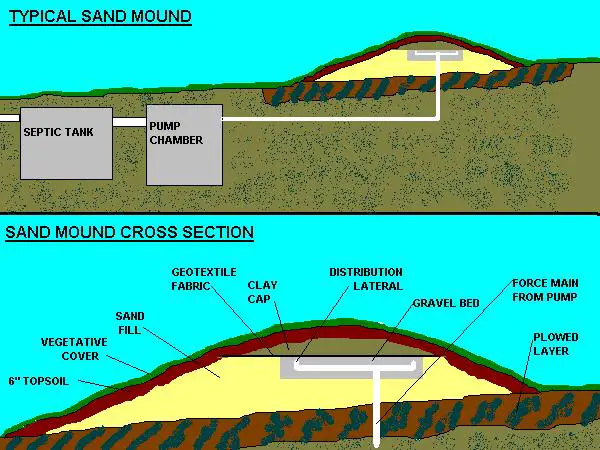Disclosure: This post contains affiliate links, meaning we may earn money or products from the companies mentioned in this post if you purchase a product through one of our links. An example would be Amazon.
What is a Mound Septic System & How Does It Work?
A mound septic system is a type of septic system that uses banks of small, permeable sand and gravel mounds to process wastewater. Mound septic systems are common in areas with sandy soils and low water table, as they produce less effluent than conventional septic systems. They are also well-suited for homes with small yards or limited space, as the system takes up very little space. This blog article is designed to help home owners or consumers better understand what a mound septic system is and how it works. By reading through this article, you should be able to make an informed decision about purchasing or installing a mound septic system in your home.

Call Septic Service Pros 1.855-925-0760 For Service or Request a Quote
What is a Mound Septic System?
The NODAK disposal system, named after North Dakota’s mound system, was first created in the late 1940s. Traditional septic tank soil absorption systems are incompatible with certain soil types.
As a consequence, particular soil and site circumstances may be addressed by employing alternative systems such as the mound system. In the early 1970s, the University of Wisconsin-Madison modified the mound design from NODAK to become the most popular today.
This fact sheet will concentrate on the Wisconsin mound design, however there are now various forms in use. Several state laws have incorporated the Wisconsin mound into their rules. A pretreatment unit(s), dosing chamber, and elevated mound are the three primary components of a mound system.
There’s a septic system for every homeowner, and mound systems are one of the most efficient and cost-effective types of septic systems. What is a mound system septic system? A mound system septic system is a sewage system that is built on a mound of earth or gravel.
This type of system is easier and faster to install than traditional septic systems, and has many features that make it easier and faster for you to take care of your waste disposal needs. Some of the benefits of a mound system septic system include: –
It’s more efficient because the system is designed to handle large amounts of waste. – It’s cost-effective because it’s designed to last longer than a traditional septic system. – It’s easier to install because the system is built on a mound of earth or gravel. If you’re interested in getting a mound system septic system installed, be sure to contact a reputable Septic Service company.

When would you use a Mound Septic System?
The mound system was created to combat 3 different types of environmental conditions that make using a traditional septic system problematic.
- Permeability of the soil- if it is too slow or too fast than a mound septic system could be a solution as compared to traditional septic systems that are more suitable for more permeable soils
- Shallow soil cover – if the layer of soil is too shallow and then becomes creviced or porous bedrock then a traditional septic system may not be feasible
- High-water table- If you property has a high water table, meaning it has a high groundwater level, than it may not be able to support a traditional septic system, and you may require a mound septic system
Any of these site conditions or a combination of these conditions can create a need for a non-traditional drain field, aka a mound.
A mound septic system is a great option for people who live in areas with heavy rainfall. The design of the system creates a grade that allows effluent to flow away from your home quickly and easily. Mound systems are also less likely to back up, making them an ideal choice for busy families. For more information on this type of septic system, be sure to read our article on how a mound septic system works here!
Call Septic Service Pros 1.855-925-0760 For Service or Request a Quote
How does a Mound Septic System work?
A mound septic system is a type of sewage disposal that uses natural soil or sand mounds to break down waste. The septic tank effluent is then collected by a pumping chamber and sent to the mound through distribution pipes . This system is environmentally friendly as it doesn’t require any wastewater treatment plants or pipelines. Additionally, it’s cost-effective, meaning you’ll save money in the long run. If you’re thinking of switching to a mound septic system, make sure to read this guide to learn everything you need to know.
Components of Mound Septic System
A mound septic system is a great option for people who live in areas with limited soil space. It is composed of three main components – the septic tank, the pump chamber, and the mound.
The septic tank is the main component of a mound system. It’s designed to hold large amounts of sewage and wastewater. The septic tank sits on top of the mound, where effluent flows into it through a drainpipe.
The pump chamber sits below the septic tank. This part of the system harvests waste from surrounding soil and water runoff, which is then pumped into the septic tank via an effluent pipe.
Finally, the mound acts as a natural filter for wastewater and effluent that travels through the system. Mound systems are easier septic tank is a large, dual-chambered buried container where wastewater from your home flows into.
This system is perfect for areas with limited soil space because it doesn’t require trenching or digging.
Additionally, the septic tank and pump chamber can be located on the same site, which reduces construction time and costs.
How much does a Mound Septic System cost
A mound septic system is an effective and affordable way to treat sewage disposal. It’s a good choice for homes with smaller yards or for those who want to save on water usage. There are many different types of systems to choose from, so it’s important to find one that best suits your needs. Installation takes only a few hours, making it a quick and easy project. Once installed, the system works silently and efficiently – leaving you with peace of mind. Whether you’re looking to upgrade your sewage disposal system or are simply curious about them, don’t miss out on this important information.
Call Septic Service Pros 1.855-925-0760 For Service or Request a Quote
Advantages and Disadvantages of Mound Septic System
If you’re thinking of installing a septic system, mound septic system should definitely be on your radar. These systems have many advantages, including: -Ease of installation – thanks to the mound design, this system is usually much easier to install than traditional septic systems. -Low initial cost – this system can be cheaper than traditional septic systems in the short and long term.
Requires minimal maintenance – the mound system doesn’t require as much maintenance as traditional septic systems, such as checking the system effluent and replacing filters. -Can be more expensive than traditional septic systems over the long term – this is typically the case for system with high effluent handling capacity. -May require regular inspections by a gardener or plumber – this is typically the case for systems that have high effluent handling capacity.
Mound Septic System problems
If you’re in the market for a new sewage disposal system, you may be wondering what is a mound septic system? Well, in a nutshell, it’s a type of sewage disposal system that uses mounds to collect waste.
The main downside of these systems is that they can become overwhelmed if not properly maintained. This can lead to sewage contamination of your water supply, which is definitely not something you want to deal with.
If you notice any signs of an impending Mound Septic System problem, it’s important to take action immediately! By doing so, you can prevent sewage from entering your water supply and causing all sorts of problems. So, if you’re thinking of upgrading your sewage disposal system, be sure to check out mound septic systems!
Maintenance of Mound Septic System
A mound septic system is a type of cesspool that uses gravity to trap and remove waste. This system is typically less expensive to maintain than other types of septic systems, making it a great choice for those on a budget.
All you need to do to keep your system in good condition is check it monthly for signs of clogging or backup, and clean it as needed. If you have any questions about how to care for your mound septic system, don’t hesitate to reach out to a professional!
What are ways to maximize the life of a septic or mound system?
If you’re looking for a septic system that’s both efficient and environmentally friendly, a mound system may be the perfect option for you! These systems are designed with a secondary drain that helps prevent backup in the event of heavy rainfall or snow melt. Additionally, proper maintenance can help keep your septic system functioning properly for many years to come. If you’re still not sure if a mound system is the right choice for you, don’t worry – we’ve got everything you need to know in this blog post!
Call Septic Service Pros 1.855-925-0760 For Service or Request a Quote
Frequently Asked Questions
How often should I check my septic system to make sure everything is working properly?
It is always a good idea to check your septic system every six months to ensure that everything is working properly. If you notice any issues, such as foul odor or telltale signs of leakage, take corrective measures right away. You can also call in a professional for an inspection if you’re not sure what to look for.
What should I do if I notice an issue with my mound septic system?
If you’re noticing any of the following issues with your septic system, it’s best to call a professional: foul odor, backed up sewer lines, heavy water usage, or red flags such as flooding. Mound septic systems are one of the most efficient types of septic systems when it comes to waste disposal. They work by harvesting and concentrating waste in a area near the sewage tank, instead of letting it spread throughout the entire system.
By doing this, mound systems are able to process waste more quickly and effectively, leading to fewer overflows and less damage to the environment. However, mound septic systems do require regular maintenance in order for them to run optimally. This includes checkups of the septic tank and pipes, as well as an annual cleaning of the system. If you neglect these tasks, it could lead to system failure and contamination. So if you notice any of the following signs of trouble with your septic system, it’s best to call a professional!
If my mound septic system fails, what are some tips for repairing or replacing it?
If your mound septic system fails, don’t panic. There are some things you can do to repair or replace it. When it comes to repairing a mound septic system, the most important thing is to prevent polluting groundwater. To do this, high pressure pumps cleanse and compacted solids onsite before release back into the environment.
In addition, the effluent is directed towards the mound rather than flowing directly into a water body. In the event of a system failure, it’s important to call an expert as repairs or replacements can be quite costly. However, with proper planning and preparation, you should be able to handle most septic system problems on your own.
How do I use my mound septic system to save money and protect the environment?
A mound septic system is a great way to protect your environment and save money on your sewage bill. It works by collecting rainwater and wastewater in mounds before it’s sent down the drain. This prevents water from flowing into streams, rivers, or groundwater – which would otherwise contaminate these sources. Additionally, since the system doesn’t rely on pipes or sewers, it’s also less likely to cause flooding during heavy rains.
Are there any drawbacks to using a mounds septic system?
There are a few pros and cons to using a mounds septic system, but on the whole it’s a very eco-friendly option that can be beneficial for different reasons. One of the biggest benefits is that a mounds septic system doesn’t rely on water like traditional sewers do.
This can be helpful if there’s scarce resources or if there’s drought conditions, as sewage treatment won’t require as much water. Furthermore, you don’t have to worry about your septic tank as much with a mounds septic system – it does all the work for you. However, due to its unique design, a mounds septic system may be more expensive than traditional sewers when it comes to installation and maintenance fees.

How often does a mound system need to be pumped?
A mound system doesn’t need to be pumped as often as a traditional septic tank. In fact, studies have shown that they can last up to 20 years without needing to be pumped. This is because the design of a mound system helps it degrade waste slowly and efficiently. This prevents flooding and odor problems.
Conclusion
A Mound Septic System is an efficient and effective way to treat sewage problems. It is a type of septic system that uses mounds to store sewage until it can be treated. This system is easier to maintain and has fewer problems than traditional septic systems. If you are looking for a septic system that will meet your needs, a Mound Septic System should be your top choice. Make sure to read through the blog for more information about the benefits and drawbacks of this system.


